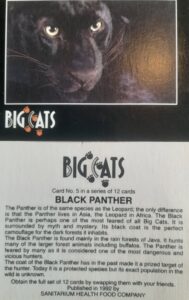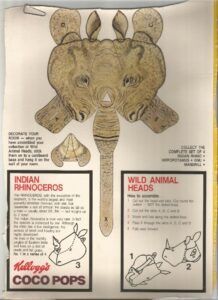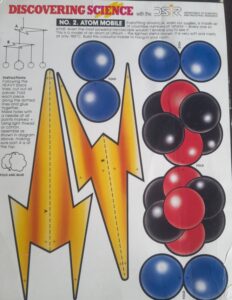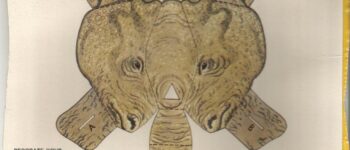1941: Intelligent Cereal Boxes
April 22, 2022
By AHNZ
I’ve been thinking about the picture cards that used to come in Sanitarium Weetbix cereal boxes. They were part of the ‘internet’ of their day. I think every digital application we use today has an analogue equivalent in the past. Much of the spam and many of the very same jokes that pass around were once delivered by regular mail or ‘written on the subway walls’.
Only the medium is ephemeral whereas human drives are a constant. Go deep down enough into philosophy and you find what some call the logos or others Platonic Forms; Universals. The technology changes, the way we express our drives or satisfy our means of production changes, but, as Gandalf says, “Well, what can I tell you? Life in the wide world goes on much as it has this past Age, full of its own comings and goings,..” To look at the family life in a 2000 year old mosaic we recognise the figures and the faces as being so much like us. Ref. A mother with her children, 1,800 years ago. Alexandria, Roman Egypt
People are people. If it’s not Twitter, Facebook, Instagram, Youtube etc. serving them well they had lantern slides, carte de visite, pigeon post, public clocks, posters, badges, knuckle bones, Freemasons, band rotundas, church attendance, police station door noticeboards, many and competing print media, public speeches, town criers, timeballs, semaphore,…These things have been supplanted, often extinguished to being relics, by the modern digital successor. The breakfast cereal box and its education contents (1941-1999) is one of these lost media.
This long list from Wikipedia makes the point by showing all the Weetbix cards through the years. So does this image (left) from the back of the Kellogs Coco Pops box that allows you to build a 3D image of an Indian rino.
- 1941 New Zealand Treasury of the Years 1st series
- 1942 New Zealand Treasury of the Years 2nd series
- 1946 Advance Anzac Series – A Pageant of the Years 3rd series
- 1947 New Zealand Treasury of the Years 4th series
- 1948 New Zealand Treasury of the Years 5th series
- 1949 New Zealand Treasury of the Years 6th series
- 1950 New Zealand Treasury of the Years 7th series
- 1951 New Zealand Treasury of the Years 8th series
- 1952 New Zealand Treasury of the Years 9th series
- 1953 New Zealand Treasury of the Years 10th series
- 1954-55 Wonder Book of General Knowledge
- 1955 New Zealand Treasury of the Years
- 1956 The Evolution of Flight
- 1957 Sports & Racing Cars
- 1958-59 Famous Ships in History
- 1959 National Costumes & Flags
- 1959-60 Speed Boats & Pleasure Craft
- 1960 Rare Animals & Reptiles
- 1960-61 Speedsters of Today
- 1961 Living Birds of the World
- 1962 Cavalcade of Cars
- 1962-63 Reaching for the Moon
- 1963 Vintage Cars
- 1964 The World of Fast Cars
- 1964 The Sea Around Us
- 1965 Birth of a Nation
- 1965 Jets of the World
- 1966 Fascinating Orient
- 1966 New Zealand Today
- 1967 Marineland Wonders
- 1967 What Makes New Zealand Different
- 1968 The History of New Zealand Railways
- 1968 National Costumes of the Old World
- 1969 The Maori Way of Life
- 1971 Another Look at New Zealand
- 1971 Famous New Zealanders
- 1972 Antarctic Adventure
- 1972 Weet-Bix Super Cars
- 1973 New Zealand National Parks
- 1973 Vintage Cars
- 1974 Conservation – Caring For Our Land
- 1974 Our South Pacific Neighbours
- 1974 Spectacular Sports
- 1975 New Zealand’s Booming Industries
- 1975 Timeless Japan
- 1976 Cars of the Seventies
- 1976 New Zealand Energy Resources
- 1977 Discover Indonesia
- 1977 The Story of New Zealand Aviation
- 1977 The Story of New Zealand in Stamps
- 1978 Looking at Canada
- 1978 Wonderful Ways of Nature
- 1979 History of Road Transport in New Zealand
- 1979 New Zealand Rod and Custom Cars
- 1980 Our Weather
- 1980 Treasury of Maori Life
- 1981 Farewell To Steam
- 1981 Our Golden Fleece
- 1982 Exploring Our Solar System
- 1983 Big Rigs
- 1983 The Many Stranded Web of Nature
- 1984 New Zealand Reef Fish
- 1984 New Zealand Summer Sports
- 1985 Mammals of the Seas
- 1986 Big Rigs at Work
- 1986 The Wild South
- 1987 Exotic Cars
- 1987 100 Years of New Zealand National Parks
- 1987 New Zealanders in Antarctica
- 1988 Your Journey Through Disneyland
- 1989 Discover Science with the DSIR
- 1989 The 1990 Commonwealth Games
- 1990 Look At How We’ve Grown
- 1991 Saving the World’s Endangered Wildlife

- 1992 Kiwis Going For Gold
- 1992 Big Rigs
- 1992 Living in Space
- 1993 The Weet-Bix Peanuts Swap Card Series
- 1993 The Wonderful World of Disney
- 1994 Our Sporting Heroes (Hall of Fame)
- 1994 Weet-Bix Stamp Album
- 1995 The Aviation Card
- 1995 The Motorbike Card
- 1996 Hunchback of Notre Dame
- 1997 World Ball Skill Cards (Basketball)
- 1998 Then & Now
- 1998 Speed 12
- 1999 Give it a Try
- 1999 Collective Force – NZ All Blacks
- 1999 Takes you to the next Level
- 2000 All Blacks Best Moments
The half-century of intellectual breakfasts came to an end in 1999 as it regressed to propaganda about the government rugby team. The impressive record not only shows how smart New Zealanders once were but also charts the range of changing interests from year to year. The cards could also be added as collectible illustrations for albums that they would complete. In the end you had a book full of information. Leading the way was the 1941 New Zealand Treasury of the Years which lasted 10 series and tapped into the enthusiasm for our centenary from Crown Colony to…whatever we are now.
You might say that the internet had taken over the role once played by breakfast boxes but in 1999 it was still too early for a media transition; The internet was not mainstream enough among kids yet. A similar incomplete explanation applies to cereal box toys which were replaced by access to better, more sophisticated, toys now affordable and available in the retail environment. Ref. 1950s: Free Gift Inside
“Weet-Bix in New Zealand has frequently released sets of collector cards, puzzles, photos and vouchers inside Weet-Bix packs since the 1930’s. Weet-Bix packs produced between Autumn and Spring since about 1999 have contained cards with pictures of All Blacks. Up until 2006, the cards were used as collector cards and promotional items. Since 2007, some of the cards have been made up for games with player statistics.” – newzealand.fandom.com
“History and heritage was so important to New Zealanders in these early 1970s that even Milo used ‘Highlights of New Zealand History‘ branding to sell their product..” – 1971: New Zealand’s Heritage: The Making of a Nation, AHNZ
The AHNZ explanation for the change up is that a new generation came along, the Millennials, who had less intellectual enthusiasm for a smart kid’s breakfast. The balance of kids grown up in the new millennium don’t have the IQ for complex things like building an atom, or a rhinoceros, or lunar lander, or a Himalayan hiker’s campsite, or Richard Pearse’s aeroplane. Their dominant faculties, as we have seen, have been a misspent Emotional Intelligence. Their concern about Social Justice, Political Correctness, Identitarianism is not something anyone needed or wanted packed in as a Complimentary Good served with their milk and cereal.
—
Image ref. Indian Rino, Kellogs; AHNZ Archive
Image ref. Atom Mobile, Sanitarium (presumed;) AHNZ Archive
Image ref. Big Cats, Sanitarium (side A and B;) AHNZ Archive
6 thoughts on "1941: Intelligent Cereal Boxes"
Leave a Reply
 Like Comment Share
Like Comment Share








My great grandfather cyril joseph hayden whom I never met in person was the first artist to design the wheetbix cards ..I’ve been trying to find some images online and have had no luck ..I’d very much like so see any images or anything at all you may have on this man I never met ..
Thanks
Regards
Kerry knox
That would be a great connection for you to make. If I were searching I’d look for a book about the history of Sanitarium. And perhaps consult New Zealand Cereal Toys 1950-2000, Stephen Summers & Peter Fisher (2006) however they’re into the toys not the cards.
Ref. http://ahnz.anarkiwi.co.nz/1950s-free-gift-inside/
Suggest you contact Darian Zam who is the expert on New Zealand commercial art. If anyone knows how to find out it’s him and I wouldn’t be surprised if he already had images on his site.
Ref. https://longwhitekid.wordpress.com/
Let me know how you get on?
Cyril Hayden 1909-1996 Advertising Manager for Coull Somerville and Wilkie, Dunedin. He designed the first cards to go in the Weetbix boxes. In his 1941 proposal to Sanitarium, the first set was 10 cards of early NZ shipping (Card No 1 of the Heemskerck; Card 2 of the Endeavour). The second set was of NZ Pioneers (Card 11 was Captain Cook). The third set was of NZ birds and the fourth set of NZ Maori Chiefs. (see….
I have copy and pasted above what info I have managed to find on him .would love to see some of these images of the cards he painted
Hi Kerry,
I see some of them on the following Flickr account. Is this yours? I see it includes a cover letter to Sanitarium (back in the days I lived in Papanui and you could smell what they were making…)
There are a few pictures here. I think I’ve got some in an album from being re-used at a later date if you’re interested.
https://www.flickr.com/photos/usakiwis/albums/72157626455938553/
Frederick Carr (Carr Studios) did a lot of the earliest Sanitarium albums, Treasury of the Years. He worked closely with Bernard Roundhill at Coull Sommerville Wilkie in the 1930s where they both studied American graphic design and Art techniques from foreign magazines. They both worked on the Timaru Milling account (Diamond products etc) doing the albums. After they both served in WWII they both moved to Auckland and started their own studios independently of each other, and both independently kept the Timaru Milling account for albums and cards into the 1970s. Rather than doing the cards himself (it wasn’t really his style), Roundhill would have assigned other Artist in his studio to work on them. Other Artists who worked on Sanitarium cards, or their art was licensed to Sanitarium were William Krogman (1960s) and Fleck (1960s).
More commercial Artists known rto work on card albuma were Michael Coombe for Greggs (1960s-1970s) George Wood for Buchanan’s/Holly cereal products , Bernard Roundhil Studios for Diamond/Timaru Milling (1940s-1970s) Nevile Lodge for Mobil (1960s) and Richard King for Golden Stamp Books/Golden Press. You’re welcome
I have a vast archive of Sanitarium stuff and also on Frederick Carr and Bernard Roundhill. A lot of the Treasury of the Years stuff has been filed to as a ‘maybe’ under Carr until more information came in to clarify things, which I believe this is, given Cyril Hayden’s potential involvement was unknown until now.
Some crucial background I omitted above, through a large part of the 1930s Roundhill was the Art Director at CSW and Carr worked under him. I think I failed to mention that above. I
believe Cyril Hayden started as an Artist there in the 1930s so would have been under Roundhill before ascending to advertising manager which was a role of coordinating client accounts for advertising artwork, not doing it himself per se, although in this case I believe he did or at least, had to go back to it out of necessity; I’ll explain this more.
So in the thirties it’s quite possible he contributed to the Peter the Pilot albums as an Artist but, on a flying look I only still see Carr and Roundhill’s hands in it. CSW was a firm that almost as a rule erased Artist’s signatures from the finished work which is unhelpful in retrospect when trying to analyse such as in this situation.
I’ve been re-examining my material over the last couple of days and comparing the material claimed to be by Hayden in the presentation.
https://www.flickr.com/photos/usakiwis/5656196429/in/dateposted/
Just because Hayden was coordinating the proposal submission for the Sanitarium card albums EOI does not mean he actually did any or all of the artwork that is in it, and at present there isn’t anything else of his to compare it to. However it has always seemed fairly clear to me that there was more than one Artist who worked on the cards. If Hayden did the other cards he definitely had a style that differed from Carr and Roundhill.
I don’t think the advertising Art promo of the boy with the album is his,
https://www.flickr.com/photos/usakiwis/5656770404/in/dateposted/
It’s possibly by Carr but I am not convinced of this either. Obviously they weren’t the only 3 Artists working in the department.
Upshot is, utilizing the information on the WWII service of all 3 and the date of issues of the Treasury of Years albums which ran off and on over a 15 year period, it’s clearer who was involved in the Sanitarium albums and who was not.
Roundhill was requisitioned by the RNZAF offices as a map draughtsman by close 1939 so never had any involvement in the Sanitarium card albums account. After his service he did not return to CSW or do freelance work for them I currently know of through his Auckland Studio he founded c1946.
Carr left for service by close 1941, he did not return to CSW or do freelance work for them I currently know of through his Auckland Studio he also coincidentally founded c1946. Therefore I can see he worked on the first album, as I can pick out his style as opposed to the other Artist whose work is attributed to Hayden.
Hayden or the artwork attributed to him was included in the first album. By 1942 enlistment had created a staff shortage so he probably returned to doing more of the actual Art and assuming the Art director’s role since there was no longer one from end 1939 although, Carr was also very capable. Then Hayden left by 1943 to serve until 1946 when he returned to CSW.
Interesting the Treasury of the Years albums stopped being produced between 1942-1946 which is telling. Rationing/restrictions would have been a contribution as anything frivolous was cut because of limited ink and paper usage. But also because, there was a shortage of staff to create them.
1946 onward Hayden probably contributed to the albums a lot more out of necessity. I can see his, or the attributed Artist’s work in 1943 and here and there through the 1950s but by the late 1940s clearly other Artists with very different styles have been brought in to work on them.
It should be kept in mind doing these cards/albums took a village as they say, it was a massive amount of work and deadline pressure, so it is hard to imagine many Artists would be capable of doing one alone, although Carr could and did many Timaru Milling albums on his own later.
Full disclosure, it looks like they reused work from Carr and Hayden/attributed to, intermittently in different Treasury of the Years and other themed albums through to 1958. Hayden or the Artist attributed as, had work included in ‘New Zealand Treasury’ (not ‘of the Years’ series) issued 1944 which has been omitted from the list above.